At this point, you have transformed the customer voices into a high-level set of requirements with supporting quotes, statements, and images. We now need to discuss how we can go about solving the various customer requirements we have received and prioritized and turn them into product requirements. This is where an understanding of both the customer and the associated product and company technology can pay off in developing a first-of-its-kind solution.
If you started with 30 or so voices and translated them into customer requirements/needs, you likely have 40-50 requirement statements. Before we continue further, we need a way to narrow our focus so we can allocate our resources to the requirement statements that will do the most to delight our customers and maximize our investment. To narrow our focus, we will assess our requirement priorities using a process very similar to the process we used to convert customer voices into customer needs:
- Transcribe all the customer requirement statements onto yellow sticky notes like we did earlier in the chapter.
- On a whiteboard or butcher block paper, write your focus statements, such as, "What are the key customer needs for XXX?"
- Post all the yellow sticky notes on the board.
- Have individual members move all the requirements, which they feel are important, from one board to another, and remove the ones that were not moved.
- Have each team member place a red dot on the bottom right-hand corner of notes they think are worth keeping. Only one dot per note.
- Take down all the notes without a dot.
- Add a second dot and continue the exercise until there are fewer than 30 notes remaining.
- Divide 30 by the number of people on the team and round to the next whole number. This is the number of picks each member gets.
- Each person picks the note that is left on the board that they feel is the most important, reads it aloud, and explains to the group why it is important.
This continues until we have our specified number of statements.
Now that we have our 20-30 key customer requirements, we need to group and prioritize them:
- In silence, instruct everyone to review all the statements on the board and read them several times.
- Have each member try to create a mental image of the meanings as opposed to just reading the words.
- Have everyone move the sticky notes around on the board so as to create logical groupings of needs. Start by looking for two ideas that seem related in some way. Look for ideas that are related to those you already grouped and add them as well. Look for other ideas that are also related to each other and create new groups with them. As an example, one group of Post-its might all have to do with the "performance characteristics" of a printer (like speed), while another may focus on the "user interface," another may talk about "communications," and yet another deals with "additional functions" such as scanning or faxing. The goal is to do this process quickly and without a lot of agonizing. Go with gut reactions to find the interrelationships. It is possible that these needs will cross over into other topic discussions, which is okay, but it should not happen that often if you have a good discussion guide structure.
- If a team member does not like where an idea is grouped, they can move it. You can always move it back. If a consensus cannot be reached, make a duplicate sticky note and place one copy in each group.
- Typically, you should have no more than two to three yellow sticky notes in a group. Keep moving requirements around until you have 8-12 groups.
- Stop when there is little or no movement of sticky notes.
- Ideally, all the ideas can be sorted into related groups. If there are some loners that do not fit into any of the groups, do not try and force them into groups where they do not belong. Let them stand alone in their own group (see Figure 7.9):
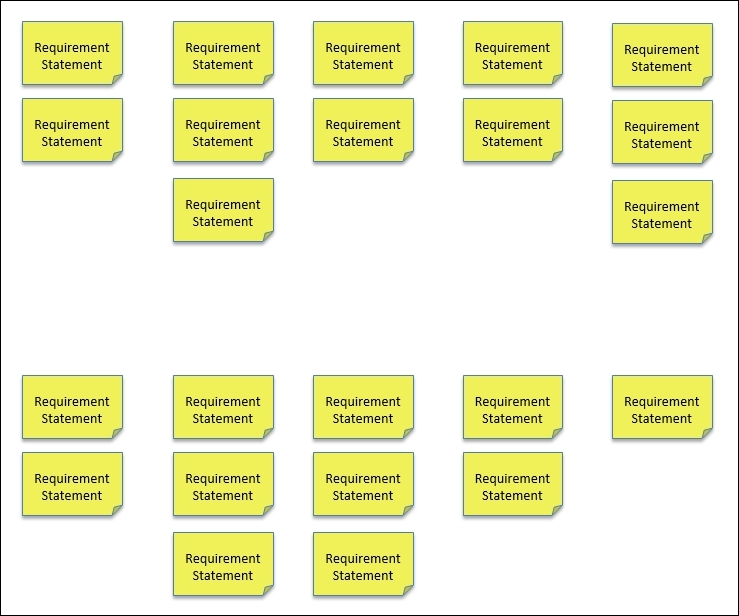
Figure 7.9: Grouping customer feedback
Allow everyone to talk. Have the team discuss why certain things are grouped together by answering the question, "Why are these particular sticky notes together?" Allow these groups to get combined if there are duplicate themes or broken apart if it appears there is the possibility that more than one theme is represented by the group. Anyone can nominate two groups that should be combined, and we will vote on whether or not to combine them. If anyone dissents, we discuss among the team why, or why groups should not be combined. After this, we will take another vote to see whether we should combine the groups, but again, the vote must be unanimous to combine them.
Make sure there were no key requirements that were missed. If so, add them, but do not use this as an opportunity to add back in your "pet" requirements.
Have the team discuss the groups and come up with a level 1 title for each that best defines the common theme in each group. Review key words or phases in each group to see what they have in common. These titles should be written in the same language as the original requirement statements, but should be at a slightly higher level of abstraction. If at all possible, use an existing quote as a level 1 title if it adequately addresses the entire need. If there is no customer requirement that addresses the entire group need, create one using the collective requirements from the yellow sticky notes.
Care must be taken so as not to try and describe everything in the group with the group title. The group title should only capture what the requirements have in common as shown in Figure 7.10. For this reason, it is likely there should be the word "and" in the level 1 title:
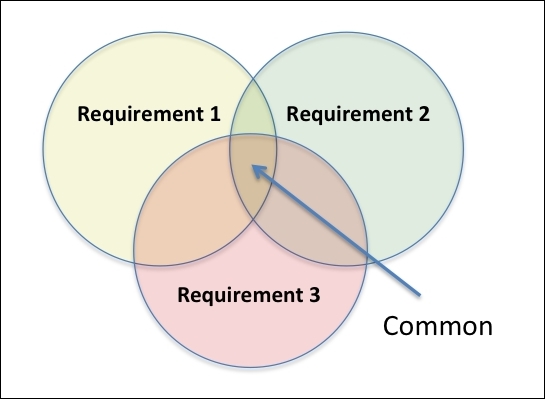
Figure 7.10
- Write the level 1 title for each group on a yellow sticky note in large, red block letters and place it above the group. If there is a yellow sticky with a customer requirement on it that is being used as a group level 1 title, draw a red block around the customer need and move it to the top of the group.
- If you have any groups that only have one sticky note, draw a red box around the customer need and use this as the group header. If you have any loners that did not fit into another group before, check if they now fit into a group once the title has been decided.
When you are done, you will have something that looks like Figure 7.11:
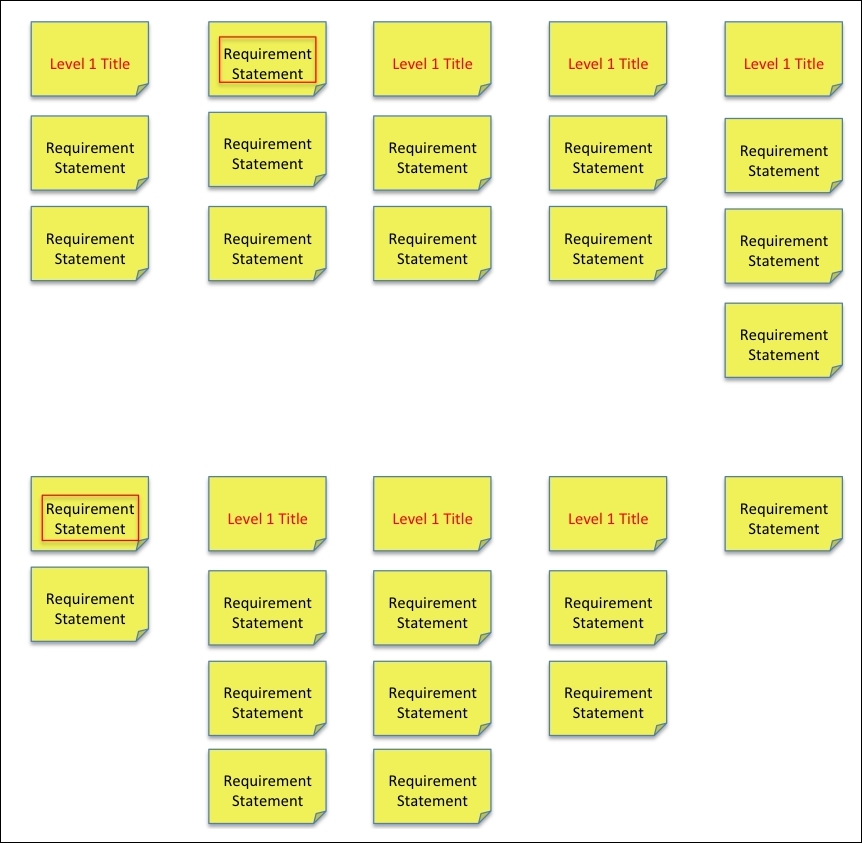
Figure 7.11
Once the requirements are grouped like in Figure 7.11, we will look for ways to group the level 1 titles into common larger themes:
- Stack the groupings so the top level 1 title or individual requirement statements show.
- Look for groups of two or three titles that share common traits, like we did with the individual requirements.
- Repeat the cluster analysis, like we did previously, by allowing the team to silently move the stacks around into common themes at a slightly higher level of abstraction. Make sure to avoid cause and effect relationships.
- Allow the team to move them back and forth until there is no more movement.
- Have the team decide on a second level title that captures the common theme for each group. These higher-level titles will help you capture overall issues and will help in communicating these items to senior management and other managers.
- Have the team write a second level title on a yellow sticky in blue block letters, using the same philosophy as before, by focusing on the words or phrases that reflect what the level 1 titles have in common, and place it above the group.
When you are finished, you will have something that looks like Figure 7.12:
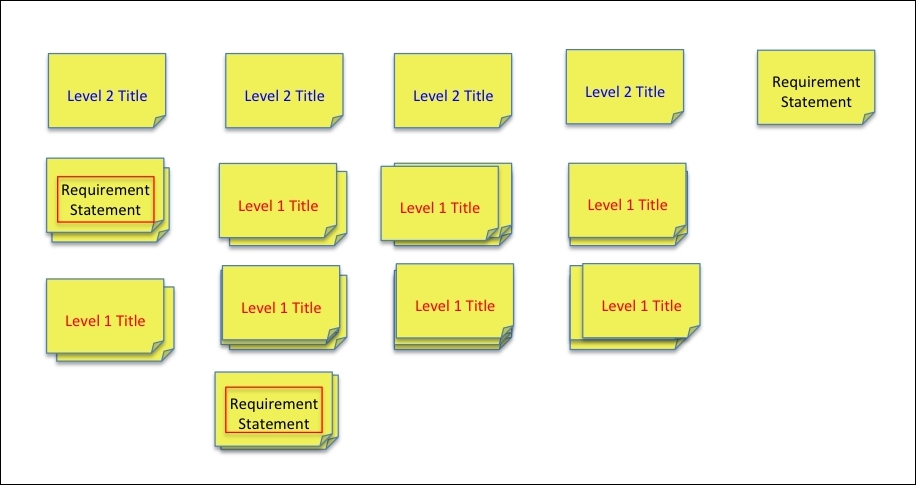
Figure 7.12
Once we are finished with this step, we need to lay out our completed affinity diagram so we can see the complete picture of what our customer interviews have told us:
- Have the team take the level 2 stacks with the level 1 and requirement yellow sticky notes to a separate board or piece of paper. This will be the final affinity sheet.
- Deconstruct the yellow sticky notes so you can see each individual sticky note, but it still retains its cluster.
- Draw a black line around each level 1 grouping.
- Draw a blue line around each of the level 2 groupings.
When complete, you should have something similar to Figure 7.13:
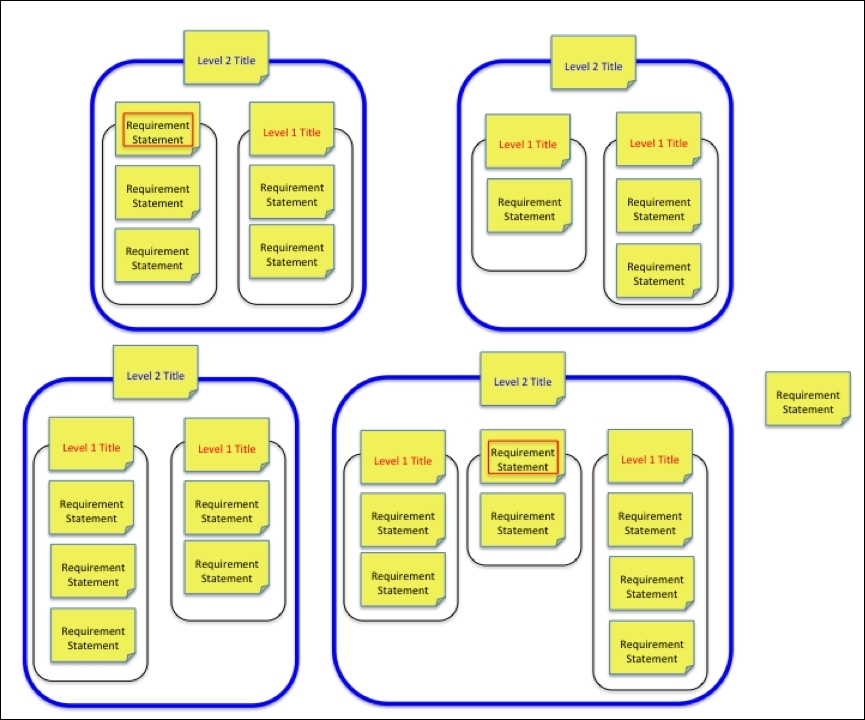
Figure 7.13
- When complete, have each participant take a piece of paper and write down the names of three level 1 headers that best address the focus question or are the highest priorities in addressing the focus question. If participants have trouble narrowing it down to three names only, have them start with five and scratch two off (yes… it really works).
- Now, have everyone rank their three choices from most important to least important on their paper where they have written the header names. This tends to be easier than trying to do both steps at once.
- Have each participant go up to the board, and on the level 1 note put three stars on their first choice, two stars on their second choice, and one star on their third choice. When complete, each participant will have marked a total of six stars on the level 1 notes.
Add up all the stars on each level 1 header and determine the first, second, and third most important or appropriate. Color in the background of the first choice with a red hash, the second choice with a blue hash, and the third choice with a green hash. Once this is complete, discuss the findings with the group and try to agree on a common conclusion. If you do, write it on the upper right-hand corner of the chat. Have everyone sign and date the final affinity diagram in the lower right-hand corner. Your final affinity chart should look similar to Figure 7.14:
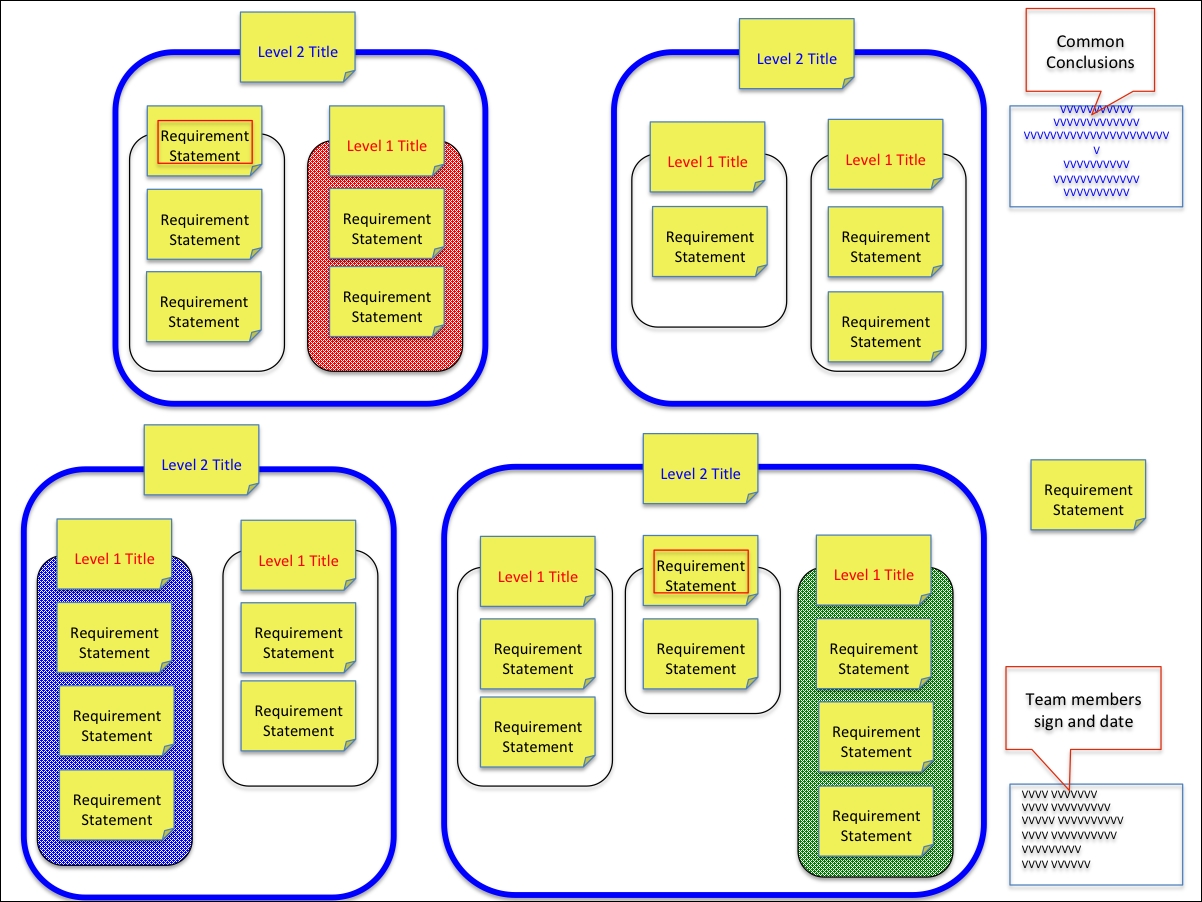
Figure 7.14
